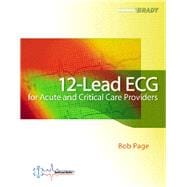
Note: Supplemental materials are not guaranteed with Rental or Used book purchases.
Purchase Benefits
Looking to rent a book? Rent 12-Lead ECG for Acute and Critical Care Providers [ISBN: 9780130224606] for the semester, quarter, and short term or search our site for other textbooks by Page, Bob. Renting a textbook can save you up to 90% from the cost of buying.
| Lead Placement and Acquisition of the 12-Lead Electrocardiogram | |
| Understanding the 12-Lead ECG Printout | |
| Determining Axis and Hemiblock | |
| Understanding Bundle Branch Blocks | |
| Determining Patient Risk for Complete Heart Block | |
| Wide Complex Tachycardia | |
| Acute Myocardial Infarction Pathophysiology | |
| ECG Patterns of Infarction | |
| Locating the AMI: The Secondary Survey | |
| The 15-Lead ECG | |
| Left Bundle Branch Block and Acute MI | |
| Chamber Enlargement | |
| Electrolyte, Drug, and Other ECG Changes | |
| Putting It All Together | |
| Answer Key | |
| Table of Contents provided by Publisher. All Rights Reserved. |
The New copy of this book will include any supplemental materials advertised. Please check the title of the book to determine if it should include any access cards, study guides, lab manuals, CDs, etc.
The Used, Rental and eBook copies of this book are not guaranteed to include any supplemental materials. Typically, only the book itself is included. This is true even if the title states it includes any access cards, study guides, lab manuals, CDs, etc.